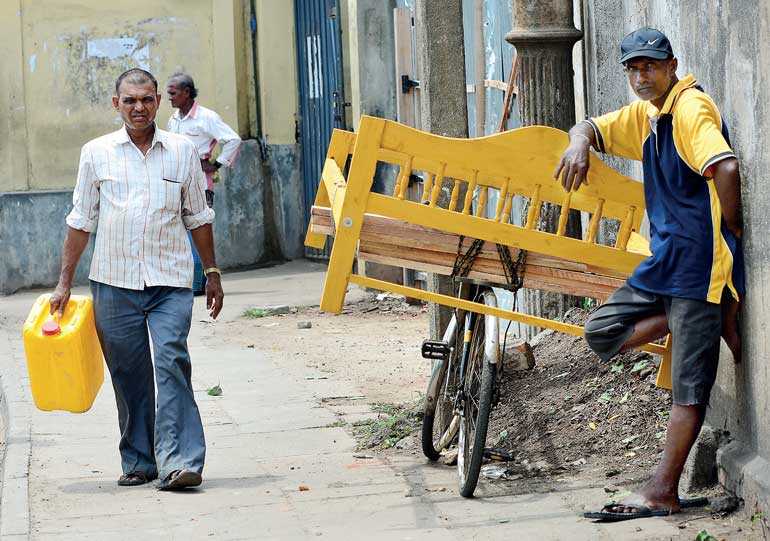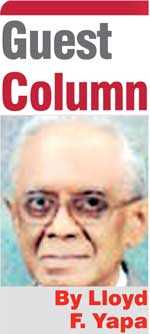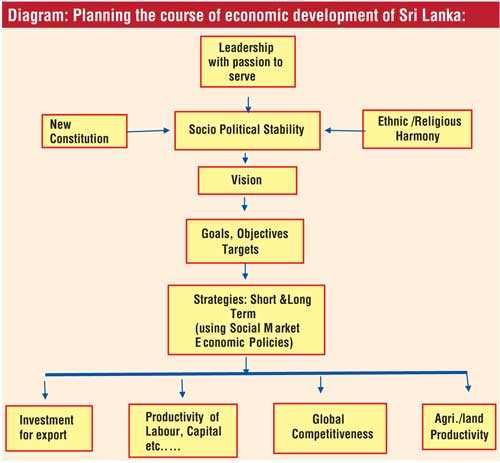Tuesday Nov 18, 2025
Tuesday Nov 18, 2025
Thursday, 7 November 2019 00:00 - - {{hitsCtrl.values.hits}}

The candidates, especially the top two, do not have well-thought-out strategies to improve the real (inflation adjusted) incomes of the people or to reduce income inequality – Pic by Shehan Gunasekara
The people of this country are due to elect a president this year and a government headed by a prime minister next year.
So far the experience of the people of Sri Lanka, however, is that their leaders of the past have not only failed to deliver on their basic needs but have also led the economy into a situation of bankruptcy, while committing extensive fraud to enrich themselves. Hence the need to elect new but effective and honest leaders. See the diagram. What follows the last line in the diagram are sub strategies and action plans under each strategy.
Political stability
The second item in the diagram is creation of social and political stability by formulating a new constitution after consulting with the people and the other stakeholders mainly to attract investments.
The UNP candidate has promised that a new constitution will be formulated through a referendum or in consultation with the people. The SLPJP candidate has also mentioned that a new constitution will be formulated but has not stated whether the people will be consulted. Both have not given reasons as to why it is to be done and what its contents will be.
This stability can only be created by an honest leadership which has a passion to serve the people (not a desire to amass votes by making promises which the country cannot afford to keep) and who would be brave enough to include in the constitution certain proposals such as: 
a) setting up a Council for Ethnic and Religious Affairs, make activities promoting ethnic and religious disharmony an offence punishable with imprisonment for three years or a fine or both as in India and a full and complete declaration of fundamental rights as in South Africa, to create ethnic and religious harmony,
b) for reduction of corruption like changing the unit of election from the district to the smaller constituency to reduce election campaigning expenditure and compulsory declaration of wealth by members of parliament as well as of local bodies,
c) provisions to improve the efficiency of the public service by making it independent of the political set up and enabling appointments and promotions on merit alone and so on, as it is the prevailing constitution that is mainly responsible for the absence of socio political stability in the country .
If this cannot be done clashes among the various communities will continue and not only foreign direct investors and even local investors will keep away while people with skills and professionals will continue to migrate out of the country as before. In other words if this part of the diagram cannot be implemented, it is better to forget about the rest.
Vision, goals, objectives
Vision, goals and objectives are next in the diagram. The vision or goal of any president or government of SL should be alleviation of poverty (or increasing the inflation adjusted incomes of the people). Poverty in the country was about 32% of individuals earning less than $ 2.5 per day in 2012/13 according to the World Bank (now it must be very much higher especially due to the poor performance of the current government, poverty has to be alleviated while reducing the high income inequality in the country; there is a wide gap between the share of income of the highest 10% of earners which was 38%, while that of the lowest 10% was only 2.0% in 2012 (World Bank).
The two leading candidates have not mentioned their visions though they have indicated their goals or qualitative objectives .The UNP candidate has stated that his objective would be to make Sri Lanka a ‘prosperous nation with a fair distribution of incomes among all classes’; that is quite good.
The SLPJP candidate on the other hand says that his objective would be to ‘improve the domestic economy and protect national security’. He also gives quantitative objectives such as an economic growth of 6.5% and a per capita income of $ 6,500 in five years. He does not talk about working towards income equality. The objectives of the two candidates are therefore fairly clear.
Development policies and strategies
Next in the diagram are development policies and strategies. As for the type of policies/strategies of economic development to be adopted, the UNP candidate has stated that he will avoid neoliberalism, as if SL’s economy has failed due to its adoption.
So what then is neoliberalism? It is a ‘modern politico economic theory favouring free trade, privatisation, minimal government intervention in business, reduced public expenditure on social services etc.’ (The Free Dictionary) as practised in the USA. 
My opinion is that it has never been adopted by SL after 1956; may be to some extent for a short period between 1977 and 1993; certainly never after 2005. The implied criticism that the collapse of the Sri Lankan economy at present is due to the adoption of neoliberal economic policies is incorrect; it is due mainly to the absence of socio political stability as well as poor governance, inconsistency of policies, poor implementation of development plans, etc.
The current Government and the previous administration have been following the same policies emphasising mainly on State activity; they have neither privatised the 400 or so loss making state owned enterprises, nor reduced Government expenditure; import tariffs particularly para tariffs like cesses (and regulations) have not been reduced to improve global competitiveness; local enterprises therefore enjoy heavy protection, ‘The present import regime is one of the most complex and protectionist in the world’ (Sri Lanka: A Systematic Country Diagnostic, World Bank 2016).
Therefore it has been a policy with an anti-export bias that should not be advocated by any future president or government. However, the indications are that may be the policy of the presidential candidate of the SLPJP as he talks about developing the ‘domestic’ economy, a pity as a man with proven capability is assigned to implement a programme that will not benefit SL.
Investment
Now let us turn to the last line in the diagram. As for the specific means of economic development to be adopted, a very important strategy that the presidential candidates seem to be ignorant of is regarding the measures necessary for of attraction of investment to create jobs and produce goods for the internal or the export market.
The amount of investment required for the economy to grow at about 8% per annum is estimated to be about 35-40% of GDP. However the country saves only about 27% of GDP on average (during the past five years). So FDI is essential to make up the balance. Moreover, FDI can bring in addition skills, technologies and global market access that are hardly available locally.
Unfortunately, SL has attracted FDI worth only about $ 9.7 billion up to 2016 whereas the inflow of FDI into Singapore was $ 1.1 trillion by that time according to UNCTAD. The reason for this inability is that FDI has avoided SL due mainly to the absence of socio political stability as stated earlier.
Statements like ‘our government will take over the state owned enterprises which have been ‘sold’ by the current administration’ will not help in the endeavour to attract FDI. The word ‘sold’ shows a surprising lack of understanding of what higher inflows of FDI can do to an economy; the per capita income of $ 58,000 realised by Singapore in 2017 was due mainly to the FDI inflows of $ 1.1 trillion attracted by them by that time supported by strong and un-corrupt leadership with a passion to serve the people, good governance and social market economic policies defined as ‘an economic system in which industry and commerce are run by private enterprise within limits set by government to ensure equality of opportunity and social and environmental responsibility’ (The Free Dictionary), as adopted by most of the successful economies in the world.
Export development
As mentioned earlier, the SLPJP candidate talks about developing the domestic economy; does this mean that he will not emphasise on a policy to attract investments to expand exports? If so how can SL pay back its foreign loans amounting to $ 54 billion and pay for essential imports?
The UNP candidate, however, talks about expanding exports (which is most desirable because the domestic market is too small to generate sufficient incomes for the people; the country has also to turn to the global market to earn the dollars to pay back the country’s massive foreign debt and to pay for imports). The UNP candidate says that he will ensure the implementation of the National Export Strategy drawn up recently for this purpose. The NES, however, does not deal with the mechanisms required to create socio political stability to attract investments especially export-oriented FDI.
As the diagram shows, the UNP candidate should not stop at attracting export-oriented investment. The market has to be opened up by lowering tariff protection so that local businesses will be compelled to compete with the businesses in the rest of the world. It is this competition that will motivate businesses to make additional investments and add better/superior value to export products than other suppliers so that foreign customers would be happy to continue to pay higher prices.
Apparently the SLPJP candidate and the JVP candidate may not adopt such a policy as they appear to be interested in protecting the local businesses. SL definitely cannot move forwards without such policies.
Subsidies and more subsidies
While dong this the UNP candidate has to keep costs down by balancing the budget as far as possible while improving productivity i.e. by helping for example to get more outputs from the same inputs by developing factors of production like capital and labour/technical and soft skills (creativity, communication particularly in in English which the UNP candidate rightly wants to introduce) and digitisation, etc.; he as well as his main rival cannot obviously keep costs down as their approach is to offer more and more subsidies that the country cannot afford for harvesting votes rather than a desire to achieve their objectives mentioned above, unlike the JVP candidate.
To make matters worse both of them appear to want to continue with the loss making state owned enterprises as well when austerity which involves cutting down on such unnecessary government expenditure drastically, while increasing (direct) tax collection, is the only option available to control continued budget deficits and rising prices; in the Vote on Account passed recently public expenditure is Rs. 4,410 billion while public revenue is Rs. 2,235. This is a massive deficit of Rs. 2,075!
So the budget deficits in the coming five-year period will most certainly be very much higher than this due mainly to the generous subsidies offered by the candidates, giving rise mainly to further rises in consumer prices.
Development of agriculture
The major strategy for development of agriculture is not free this and that, as all that will go down the river so to speak, but the improvement of the productivity of farmers especially by increasing the size of land holdings and giving ownership of the lots to the farmers by undertaking land reform; the productivity of agriculture or the value added per worker in that sector in SL was $ 2,788, while that of Malaysia was $17,874, Mauritius $ 10,193 and South Korea $ 19,434, while that of Israel was $94,562, constant 2010, World Bank, 2018.
SL has essentially to undertake such land reform supported by agricultural extension/assistance programmes, rural infrastructure development and large scale cultivation of selected crops with higher returns to increase rural incomes instead of offering subsidies and resorting to protection of agricultural production from imports as stated by the SLPJP candidate.
The latter policy will invariably increase the prices of some agricultural products for local consumers and make exports of such products impossible as subsidies will tend to lead to cultivation of products that the country cannot produce at competitive world prices.
It should also be added that another step that is required to develop agriculture is to reduce the number of people engaged in it by absorbing the excess workers in the agricultural sector (24% of the workforce currently) into the manufacturing sector for increasing the size of land holdings for raising land productivity; this also needs investment. It will also reduce the pressure on the natural environment especially the forest reserves and the animal population including the elephants whose habitats have been taken over by humans.
Conclusion
What all this means is that the candidates, especially the top two, do not have well-thought-out strategies to improve the real (inflation adjusted) incomes of the people or to reduce income inequality.
The UNP candidate rightly thinks of expanding exports as there is a dire need to pay up the massive foreign debt without resorting to further foreign borrowing. He has spoiled his chances of succeeding in in such an endeavour by engaging in a contest with his main rival the SLPJP candidate to catch votes by offering a ludicrous package of subsidies that the country cannot afford.
The SLPJP candidate has apparently been forced to offer continued protection to domestic enterprises although a small country like SL cannot ignore the need to create socio political stability to attract investments particularly to expand exports rapidly to become prosperous like the East Asian ‘tiger’ economies.
Unfortunately these candidates also do not offer a credible strategy to reduce rural poverty and improve the global competitiveness of agricultural production for the local and export markets. So it appears that the country has therefore been compelled to forego the last opportunity it has been given to become prosperous and instead decided to move steadily down the road to a failed state status.
(The writer is a Development Economist.)